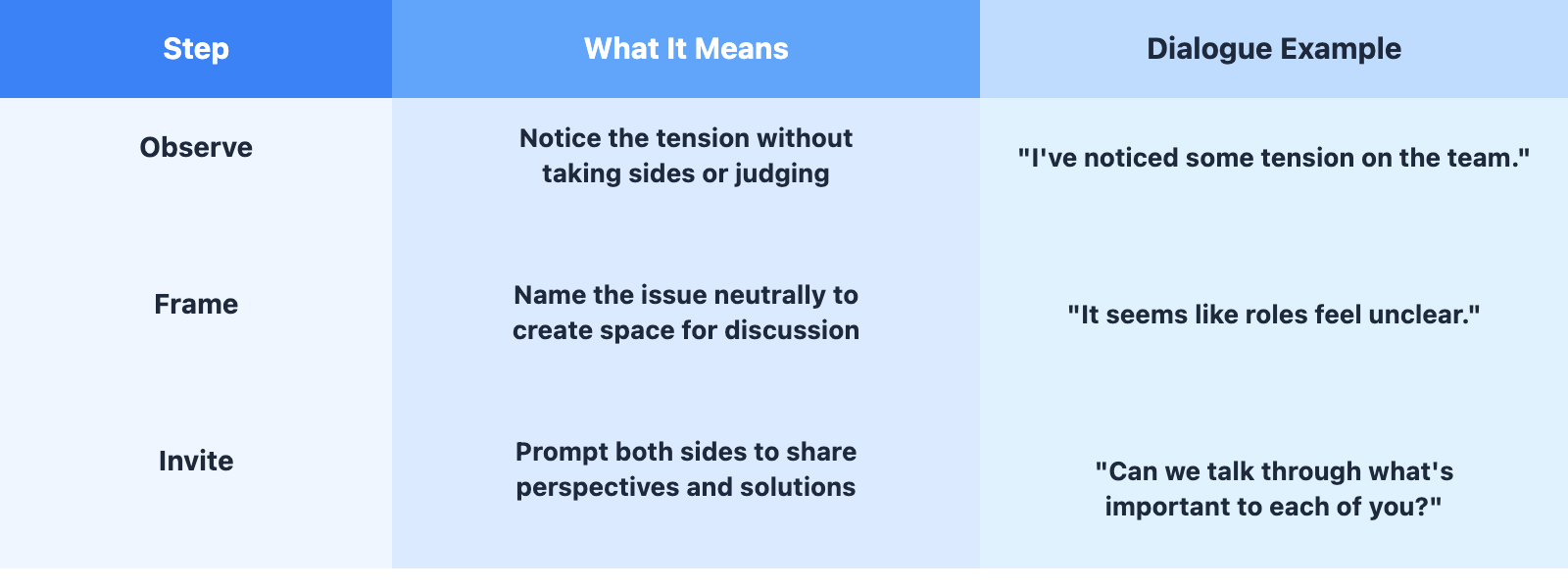Welcome to your journey in mastering conflict mediation. In this unit, you’ll learn how to step into peer and team conflicts as a neutral, trusted presence—helping others move from tension to understanding without taking sides. These skills are essential for anyone who wants to foster a collaborative, healthy work environment, whether you’re a manager, team lead, or simply someone who cares about team dynamics. As you progress, you’ll discover how to surface tension constructively, facilitate honest dialogue, and guide teams toward shared solutions.
When you notice tension between colleagues, your first challenge is to address it without appearing to favor one side. Neutrality is all about your words, tone, and timing. For example, instead of saying "I think Alex is right, but let's talk about it", a more neutral approach would be "I've noticed some tension around project roles—let's discuss how we can move forward together." The second phrasing surfaces the issue without blame and invites both parties to participate.
Effective mediators name the tension clearly but without judgment, avoid language that assigns blame, and invite open conversation. A strong opener might sound like: "It seems like there are different perspectives on how to approach this project. Can we talk through what’s important to each of you?" This approach helps everyone feel seen and sets the stage for productive dialogue.
This chart shows a step-by-step breakdown of neutral framing in conflict mediation:

Here’s a realistic example of how to step in neutrally when two teammates are clashing over responsibilities:
- Chris: Jake, I feel like I’m always picking up the last-minute tasks, and it’s starting to get overwhelming.
- Jake: That’s not fair, Chris. I’ve been handling the client calls and the reports every week.
- Chris: I get that, but the extra admin work keeps falling on me, and it’s not sustainable.
- Natalie: I can see both of you are frustrated. My goal isn’t to take sides, but to help us get clarity on how the work is being divided. Can we each share what’s been most challenging, so we can figure out a better balance together?
In this exchange, Natalie demonstrates neutral framing by acknowledging both perspectives, clarifying her intent to remain impartial, and inviting both parties to share their experiences. Notice how she avoids blame and instead focuses on understanding and collaboration.
Even with the best intentions, mediators can unintentionally lose neutrality or escalate tension. Here are some common pitfalls and strategies to avoid them:
- Taking Sides (Even Subtly): Avoid agreeing with one person’s perspective, even with body language or tone. Instead, reflect back what you hear from both sides equally.
- Letting Emotions Take Over: If the conversation gets heated, pause and acknowledge the emotion without judgment. For example:
"I can see this is a sensitive topic for both of you. Let’s take a breath and make sure everyone feels heard." - Jumping to Solutions Too Soon: Resist the urge to “fix” the problem immediately. Spend time understanding each person’s needs and concerns before moving to problem-solving.
- Using Absolutes or Labels: Words like “always,” “never,” or “should” can make people defensive. Stick to specific observations and open-ended questions.
Practice Tip: After each mediation, reflect on your own neutrality. Ask yourself: Did I give equal space to each person? Did I use language that was free of judgment? What could I do differently next time to maintain trust and balance?
In the upcoming roleplay practices, you’ll have the opportunity to apply these principles in realistic scenarios. You’ll practice recognizing and avoiding these common pitfalls, using neutral language, and guiding conversations toward understanding and collaboration. This hands-on experience will help you build confidence and skill as a neutral mediator in group conflicts.
